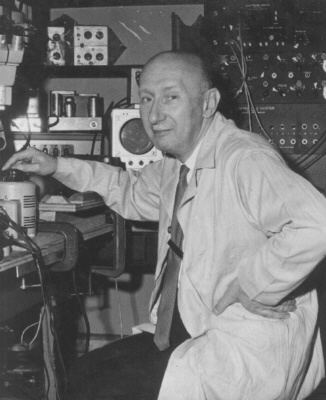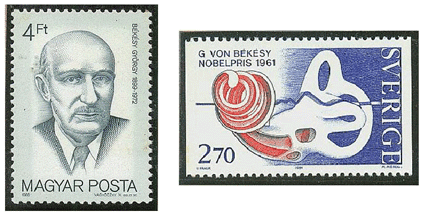Nationality Hungarian | Known for Cochlea Name Georg Bekesy | |
 | ||
Notable awards Nobel Prize in Physiology or Medicine (1961)ASA Gold Medal (1961) | ||
Nobel medicina y fisiologia 1961 georg von bekesy
Georg von Békésy (Békésy György) (3 June 1899 – 13 June 1972) was a Hungarian biophysicist born in Budapest, Hungary. In 1961, he was awarded the Nobel Prize in Physiology or Medicine for his research on the function of the cochlea in the mammalian hearing organ.
Contents
- Nobel medicina y fisiologia 1961 georg von bekesy
- Georg von Bksy Wikipedia audio article
- Biography
- Research
- Awards
- References
Georg von Békésy | Wikipedia audio article
Biography
Békésy was born on 3 June 1899 in Budapest, Hungary, the first of three children (György 1899, Lola 1901 and Miklós 1903) to Alexander von Békésy (1860–1923), an economic diplomat born in Kolozsvár, Transylvania, Kingdom of Hungary, and his wife Paula Mazaly (1877–1974) born in Cadavica, Kingdom of Croatia-Slavonia, Kingdom of Hungary. Paula's father went from Pécs to Cadavica and that's why she was born there. He went to school in Budapest, Munich, and Zürich. He studied chemistry in Bern and received his PhD in physics on the subject: "Fast way of determining molecular weight" from the University of Budapest in 1926. He then spent one year working in an engineering firm. He published his first paper on the pattern of vibrations of the inner ear in 1928. He was offered a position at Uppsala University by Róbert Bárány, which he dismissed because of the hard Swedish winters.
Before and during World War II, Békésy worked for the Hungarian Post Office (1923 to 1946), where he did research on telecommunications signal quality. This research led him to become interested in the workings of the ear. In 1946, he left Hungary to follow this line of research at the Karolinska Institute in Sweden.
In 1947, he moved to the United States, working at Harvard University until 1966. After his lab was destroyed by fire in 1965, he was offered to lead a research laboratory of sense organs in Honolulu, Hawaii. He became a professor at the University of Hawaii in 1966 and died in Honolulu.

He became a well-known expert in Asian art. He had a large collection which he donated to the Nobel Foundation in Sweden. His brother, Dr. Miklós Békésy (1903-1980), stayed in Hungary and became a famous agrobiologist who was awarded the Kossuth Prize.
Research

Békésy developed a method for dissecting the inner ear of human cadavers while leaving the cochlea partly intact. By using strobe photography and silver flakes as a marker, he was able to observe that the basilar membrane moves like a surface wave when stimulated by sound. Because of the structure of the cochlea and the basilar membrane, different frequencies of sound cause the maximum amplitudes of the waves to occur at different places on the basilar membrane along the coil of the cochlea. High frequencies cause more vibration at the base of the cochlea while low frequencies create more vibration at the apex.
He concluded that his observations showed how different sound wave frequencies are locally dispersed before exciting different nerve fibers that lead from the cochlea to the brain. He theorized that the placement of each sensory cell (hair cell) along the coil of the cochlea corresponds to a specific frequency of sound (the so-called tonotopy). Békésy later developed a mechanical model of the cochlea, which confirmed the concept of frequency dispersion by the basilar membrane in the mammalian cochlea. But this model could not provide any information as to a possible function of this frequency dispersion in the process of hearing.
In a posthumous 1974 article looking back over progress in the field, he remarked "In time, I came to the conclusion that the dehydrated cats and the application of Fourier analysis to hearing problems became more and more a handicap for research in hearing," referring to the difficulties in getting animal preparations to behave as when alive, and the misleading common interpretations of Fourier analysis in hearing research.
Awards
Békésy's honours include:
